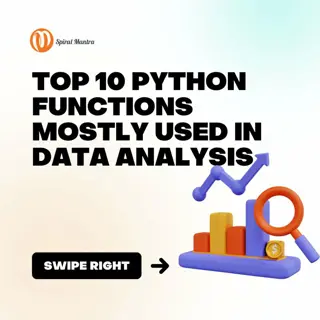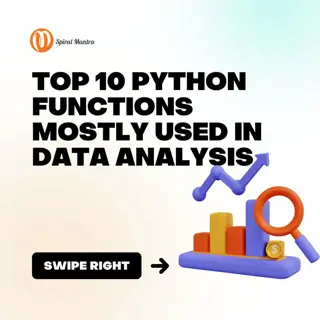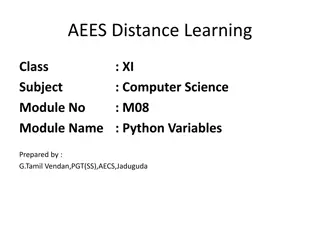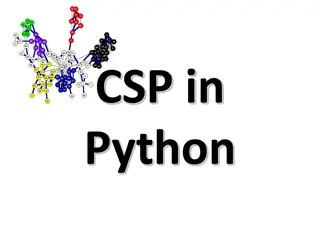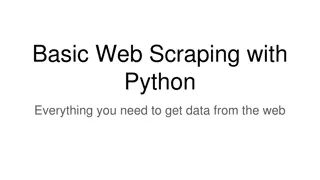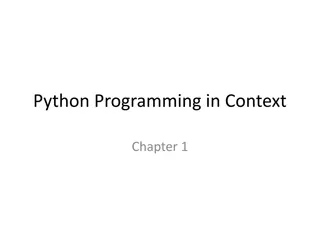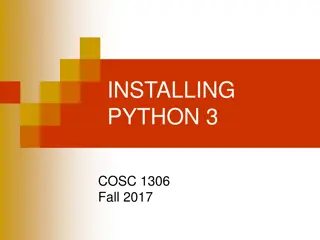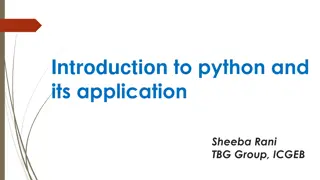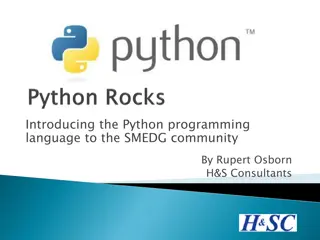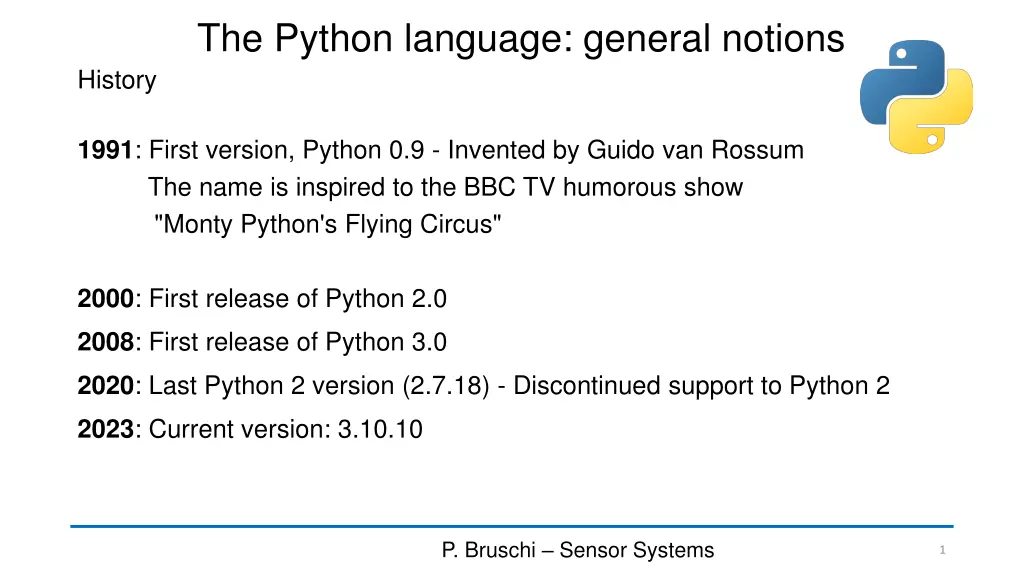
Python Language Overview: History, Characteristics, and Types
Learn about the evolution of Python from its first version in 1991 to the latest release in 2023. Explore the language characteristics, including being interpreted and dynamically typed. Discover the built-in types, array-like data types, indexing, and slicing in Python.
Download Presentation

Please find below an Image/Link to download the presentation.
The content on the website is provided AS IS for your information and personal use only. It may not be sold, licensed, or shared on other websites without obtaining consent from the author. If you encounter any issues during the download, it is possible that the publisher has removed the file from their server.
You are allowed to download the files provided on this website for personal or commercial use, subject to the condition that they are used lawfully. All files are the property of their respective owners.
The content on the website is provided AS IS for your information and personal use only. It may not be sold, licensed, or shared on other websites without obtaining consent from the author.
E N D
Presentation Transcript
The Python language: general notions History 1991: First version, Python 0.9 - Invented by Guido van Rossum The name is inspired to the BBC TV humorous show "Monty Python's Flying Circus" 2000: First release of Python 2.0 2008: First release of Python 3.0 2020: Last Python 2 version (2.7.18) - Discontinued support to Python 2 2023: Current version: 3.10.10 P. Bruschi Sensor Systems 1
Language characteristics It is an interpreted (instead of compiled) language. The interpreter must be present in the machine where a Python program is run. Python instructions can form a program ("script") or be executed in interactive shells. It is dynamically-typed, meaning that the type of data is established at run time and can change during execution. It include a "garbage-collector" that frees the memory which is no more used It is strongly object-oriented (like C++). For a complete documentation: https://docs.python.org/3/ Very useful section: Library reference P. Bruschi Sensor Systems 2
Top programming languages in 2021 P. Bruschi Sensor Systems 3
Built-in types in Python Python includes very versatile types. All built-in types are classes. Here we give an example of the most commonly used built-in types: Scalar types int (of potentially unlimited value and resolution) bool (True, False) float (double precision floating point numbers) Character arrays: str (string, array of "Unicode" characters. Characters different number of bytes. Most printable characters from different alphabets are supported) bytes (array of ASCII, characters, each one represented by a single byte, useful to communicate with hardware components) P. Bruschi Sensor Systems 4
Array-like data types Lists and Tuples : these are ordered collection of elements that can be of any type. The type included in a list (or tuple) do not need to be homogeneous. Syntax for lists: a=[12.3,"abc",10] This is a list of three elements, a float, a string and an integer. a=[[2,3],[0.23, "ab"]] This is a list, whose elements are other two lists. Tuples are simply constant lists, i.e. lists whose elements can't be changed. The syntax is the same but with round brakets: a=(12.3,"abc",10) Elements are associated to an integer index, starting from 0: a=[12.3,"abc",10] a[0] returns 12.3 P. Bruschi Sensor Systems 5
Indexing in Python Negative indices are allowed. A negative index starts counting from the bottom of the list. a=["a","b",6.1,10,5.6] a[-1] is 5.6, a[-2] is 10 and so on Slicing. Applying slicing to a list produces a subset of the original list. a[i1:i2] returtns a sublist including elements from i1 and i1-1 Example: a[2:4] returns the list [6.1,10] a[i1:i2:s] returns a sublist inlcuding elements from i1 and i1-1 by step s a[0:4:2] returns ["a",6.1] If the step is omitted, 1 is used If the start or the stop is omitted, the beginning or the end of the list are used, respectively: a[:3] returns ["a","b",6.1], while a[::2] returns all the elements with even indices (both start and stop are omitted). P. Bruschi Sensor Systems 6
Strings in Python String are very versatile object with a large numeber of dedicated functions. The class includes useful methods. If "s" is a string: s.split(sep): returns a list including the substring that can be obtained dividing "s" at any occurrence of "sep" s.find(pat): find the index of the first occurrence of the pattern "pat" into "s" s.removeprefix(prf): returns a string where the prefix "prf") is removed (if present). s.replace(old,new): returns a string where pattern "old" is substituted by "new) s.encode() : returns a byte object corresponding to string "s" b.decode() : returns a string from bytes object "b" (encoding: utf-8) P. Bruschi Sensor Systems 7
Dictionaries Dictionaries are similar to lists and tuples, but accept non-integer indices Syntax: a={"chiave a": 12.3,"chiave b": "aabb", "key":1.89} creates a dictionary. Each entry in the dictionary is formed by a key and a value. Keys and values can be of any type. Dictionaries are particularly usefun when all keys are strings, as in the example. To retrieve a value, it is necessary to specify the key, as floows: a["chiave b"] returns "aabb". a["key"], returns 1.89. P. Bruschi Sensor Systems 8
Iterables and iterators Iterables are objects including elements that can be extracted sequentially. An example of iterable object is a list. I can extract all the elements of a list as in the following example: my_list=["aa", "bb", 2, 3.34] # List definition. for x in my_list: print (x) Note that, in a list, I can also get elements in an arbitrary way: x=my_list[2] Iterators are iterables that generate their elements only a sequential way. An iterator can be read only one time. Example is the "range" iterator my_iter=range(10) for i in my_iter: print(i) Note: my_iter[2] is not allowed. P. Bruschi Sensor Systems 9
Flow control statements: conditional if <condition 1> : statement 1.1 . statement 1.n Note: each statement block to which the condition 1 applies is defined by the indentation (one "tab").The same is valid for the elif (= else if)and else sections. It is possible to introduce an arbitrary number of "else if" sections Example elif <condition 2>: statement 2.1 . statement 1.m if x==1: elif x>=2: else: z=x*45.2 print(z) else: z=2**x print(z) statement e.1 . statement e.k z=0 print(x,z) P. Bruschi Sensor Systems 10
Flow control: while loops The while loop is similar to its equivalent construct in C / C++. Here we show just an example combined with an "if" construct, in order to show nested indentation. while (x>1): if x<=0: x=x/2 print("x= ",x) x=-x print("sign reversal") P. Bruschi Sensor Systems 11
The for loop The for loop is used to iterate across the elements of any "iterable" object. Simple iterable objects are lists and tuples. Example 1 a=[1, "abc", 3.4] for i in a: print (i) Syntax: for <variable> in <iterable>: statement 1 statement n The range(i1,i2,step) function produces an iterable that includes integers from i1, to i2 with step s. Note that i2 is excluded from the set. range(10) means all integer values from 0 to 9. Example 2 for i in range(10): z=3*i print (i,z) Sequence of integer numbers P. Bruschi Sensor Systems 12
break, continue and pass continue: skips all other remaining instructions in the cycle and goes no next iteration for i in ll: if i==3: continue elif i==6: break else: pass print(i) ... print("the end") ... break: interrupts the loop and goes to the first instruction after the loop pass: does nothing P. Bruschi Sensor Systems 13
Functions in Python Functions in Python can make operation on the arguments and return any kind of data types. The type of the arguments and of the return values is not predefined and can change at run time. This is a very powerful property, but must be used with care since it can cause run time errors or data type inconsistency. Example of function definition: a, b are mandatory arguments c is an optional argument. If it is not explicitly passed to the function, the default value 2 is assumed. def my_fun(a,b,c=2): z=a*b/c return z Call to the function "my_fun" y=my_fun(1.2,2.34,33) yy=my_fun(2.5,11) P. Bruschi Sensor Systems 14
Classes in Python It is better to use an example to show the various elements of a class in Python "object" is a standard parent class, that has to be specified if our class does not inherit from a parent class Initialization function that is called when an istance of the class is created class mia(object): def __init__(self,i,v): self.current=i self.voltage=v def power(self): return self.curremt*self.voltage def resistance(self): return self.voltage/ self.current def set_current(self,cur): self.current=cur Member functions of the class a=mia(1.5e-3,2.0) creates an istance of class "mia" a.currents returns 1.5e-3 a.power() returns 3.0e-3 (3 mW) P. Bruschi Sensor Systems 15
Classes in Python: the reference "self" The reference self is used only in the class definition to represent the instance of the class. It is strictly mandatory to access the variable and functions that belong to the class. class mia(object): def __init__(self,i,v): self.current=i self.voltage=v def power(self): return self.curremt*self.voltage def resistance(self): return self.voltage/ self.current def set_current(self,cur): self.current=cur def conductance(self): return 1/self.resistance Every function must have self as first argument. Possible other arguments come after self Variables (data) that are stored in the class must be preceded by self Calls to member functions of the class must be preceded by self P. Bruschi Sensor Systems 16
Built-in components, standard library and optional modules Standard library Built-in types Built-in functions optional modules Built-in components Search path for modules: 1. Directory where the program is running 2. path specified by PYTHONPATH env. variable 3. Default python path P. Bruschi Sensor Systems 17
Modules The Python language includes a very small number of built-in functions. In order to add functions and classes, modules can be loaded. For example, if we need to use mathematical functions, we can load the "math" module: import math Loads (imports) the "math" module math.sin(10) Uses the "sin" function of module "math" Imports all functions from module math from math inport * sin(10) If functions are directly imported, it is not necessary to specify the module from math import sin, cos It is possible to import only individual functions sin(10)*cos(2) A module can be imported and referenced with a shortcut import math as mt mt.sin(10) P. Bruschi Sensor Systems 18
The Python standard library The standard python library includes modules that cover a very large variety of programming purposes. The following list shows just a few examples. Module math os sys time ctypes tkinter Function Mathematical functions Access to operating system commands (file system navigation, etc) Includes access to run-time parameters, such as command line arguments Time (current time, etc) and delay functions such as time.sleep(sec) For calling functions from libraries writen in other languages (such as C) Graphical interfaces The standard library includes mocules devoted to html, xml, json format decoding and encoding, management of e-mail servers and clients, soket implementations, string manipulation, input-output handling and much more. P. Bruschi Sensor Systems 19
Optional modules Besides the rich collections of modules included in the standard library, python programmers can rely on modules developed within the wide Python community. Some popular modules are: numpy, scipy, matplotlib: all kind of numerical calculations for scientific purposes and 2d-3d plotting functions pandas, seaborn: processing and plotting facilities for statistical data sympy : symbolic calculation pyserial a simple interface for serial ports and virtual serial ports PyVisa control intsruments that adhere to the VISA standard pyQt5 : Qt-style graphycal interfaces P. Bruschi Sensor Systems 20

